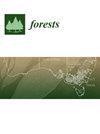蔷薇赤松诱导基因的相对表达诱导系统抗性
IF 2.4
2区 农林科学
Q1 FORESTRY
引用次数: 0
摘要
辐射松是智利最常种植的树种之一,因为它生长迅速,具有理想的木材和纸浆特性。然而,它的产量却受到多种病害的影响。由环状镰刀菌引起的沥青腐烂病(PCC)被认为是对松林产业危害最大的病害。目前已制定了几种防治措施,其中生物防治已成为一种环境友好型的有效防治方法。以前的研究支持 Clonostachys rosea 在减少 PCC 危害方面的价值,有证据表明这种药剂可能会诱发辐射松的系统抗性(ISR)。在茎尖接种 F. circinatum 前 8 天和 1 天,用基质上的蔷薇木属植物预处理 10 个月大的辐射松植株,24 小时后测定 DXS1、LOX、PAL 和 PR3 基因的表达水平。与未经预处理和感染 F. circinatum 的植株相比,经 C. rosea 预处理和感染 F. circinatum 的植株的病斑长度减少了 45%。此外,与未处理的植物相比,LOX 和 PR3 的诱导量分别增加了 23 倍和 62 倍。我们的研究结果表明,C. rosea 会引起预处理植物的 ISR 反应,显著增加抗性基因的表达并缩短病变长度。本文章由计算机程序翻译,如有差异,请以英文原文为准。
Relative Expression of Genes Elicited by Clonostachys rosea in Pinus radiata Induces Systemic Resistance
Radiata pine is one of the most commonly planted tree species in Chile due to its fast growth and desirable wood and pulp properties. However, its productivity is hampered by several diseases. Pitch canker disease (PCC) caused by Fusarium circinatum, is considered the most damaging disease to the pine forest industry. Several control measures have been established, with biological control emerging as an environmentally friendly and effective way for F. circinatum control. Previous studies support the value of Clonostachys rosea in reducing PCC damage, with evidence suggesting a potential induced systemic resistance (ISR) triggered in radiata pines by this agent. Ten-month-old radiata pine plants were pre-treated with C. rosea on a substrate at 8 and 1 days before inoculation with F. circinatum on the stem tip, and expression levels were determined for DXS1, LOX, PAL, and PR3 genes 24 h later. Lesion length was 45% lower on plants pre-treated with C. rosea and infected with F. circinatum compared to non-pre-treated and infected plants. Additionally, LOX and PR3 were induced 23 and 62 times more, respectively, in comparison to untreated plants. Our results indicate that C. rosea causes an ISR response in pre-treated plants, significantly increasing the expression of resistance genes and reducing lesion length.
求助全文
通过发布文献求助,成功后即可免费获取论文全文。
去求助
来源期刊

Forests
FORESTRY-
CiteScore
4.40
自引率
17.20%
发文量
1823
审稿时长
19.02 days
期刊介绍:
Forests (ISSN 1999-4907) is an international and cross-disciplinary scholarly journal of forestry and forest ecology. It publishes research papers, short communications and review papers. There is no restriction on the length of the papers. Our aim is to encourage scientists to publish their experimental and theoretical research in as much detail as possible. Full experimental and/or methodical details must be provided for research articles.
 求助内容:
求助内容: 应助结果提醒方式:
应助结果提醒方式:


